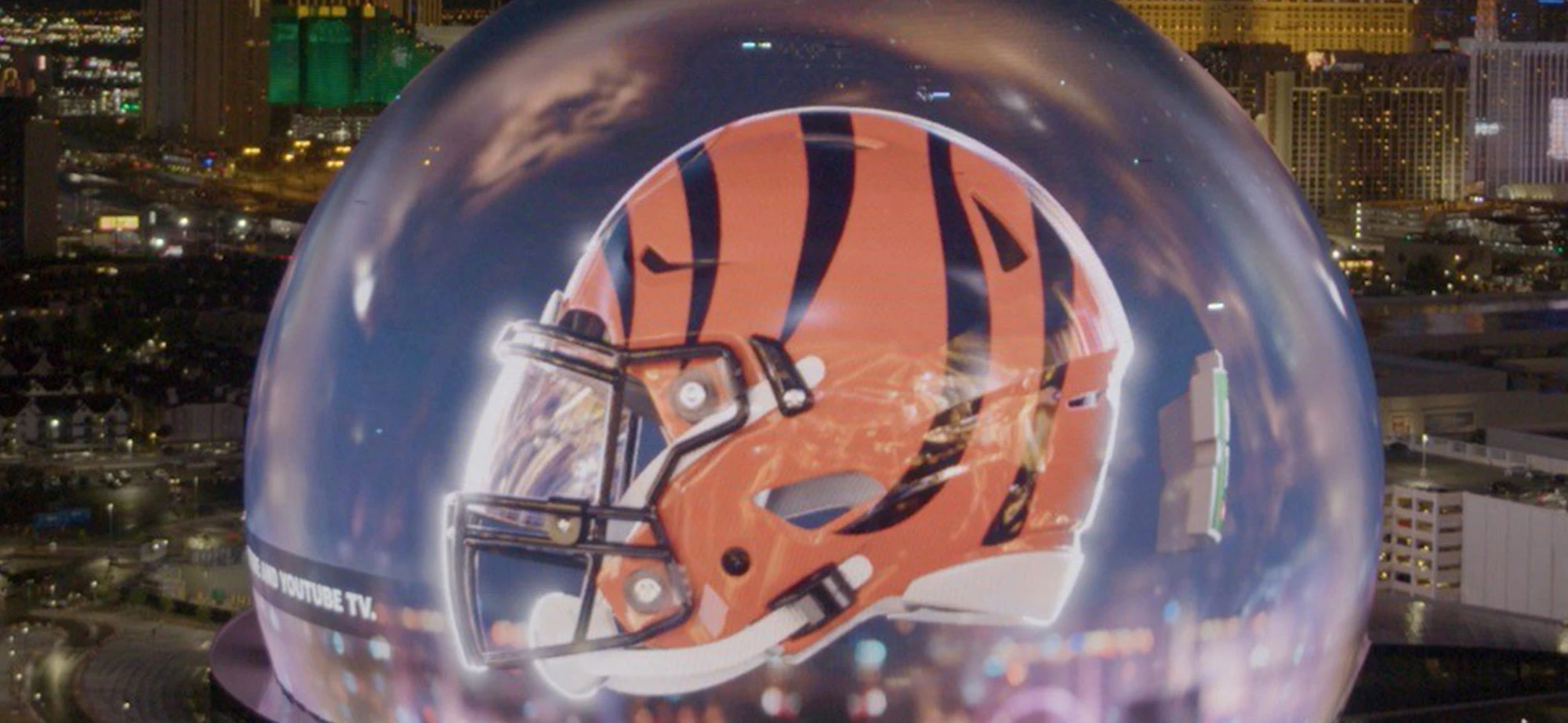Campaigns6th Sep 2023
YouTube becomes Las Vegas Sphere’s first paid ad with NFL Sunday Ticket activation
EssenceMediacom and Google secure first-to-market activation, after the agency negotiated YouTube’s ad buy with the Sphere.
Where there’s a screen, there’s an advertiser. And the 580,000-square-foot exterior of Las Vegas’s new Sphere arena is no exception.
The venue on Friday switched on a campaign promoting Google’s YouTube, its first paid-for advertising deal. The Alphabet-owned streaming service plans to take over the dome’s LED exterior for nearly two weeks to promote its NFL Sunday Ticket offer, a subscription-only package that allows customers to watch Sunday games. The Sphere had run advertising promoting the National Basketball Association’s Summer League in July free of charge. The YouTube deal kicks off what the Sphere’s sales team hopes will become one of billboard advertising’s most prestigious and lucrative media buys, rivaling the renowned advertising space of New York’s Times Square or London’s Piccadilly Circus. “What we’re offering the brands is a chance to stand out in a media that doesn’t exist anywhere else,” said Guy Barnett, the Sphere’s senior vice president of brand strategy and creative development.
The Sphere, a music and entertainment arena, was initially conceived by Madison Square Garden Entertainment on land originally leased from Las Vegas Sands Corp. and slated to open in 2021. Previously known as the MSG Sphere, the project was announced in 2018 with an estimated cost of $1.2 billion—a figure that steadily rose to a final estimated cost of $2.3 billion as delays to construction pushed back the opening date, according to Sphere Entertainment, a publicly traded company for the arena that in April split with Madison Square Garden Entertainment.YouTube and Sphere Entertainment declined to comment on the cost of the ad buy.The Sphere component of Sphere Entertainment’s business in August reported revenue of $691,000, up from $617,000 a year earlier. The first concert series at the venue—U2’s “U2:UV Achtung Baby Live at Sphere”—is scheduled to begin on Sept. 29.Sphere Entertainment has in the past year been pitching its “exosphere” billboard to advertisers at its studio in Burbank, Calif., which houses a quarter-scale, full-resolution prototype of the Las Vegas Sphere. Its ad sales team is selling blocks of 90 seconds that can be bought at frequencies suited to each advertiser, such as a couple of times a day, twice a week or twice a month, a spokesman for the company said. Brands can also choose to buy the exosphere for an exclusive chunk of time, as YouTube has done, he said.
Out-of-home advertising was once viewed by many marketers as a static, sometimes boring, medium from which results were difficult to glean. But ongoing improvements in digital billboard technology have stirred up interest in media planners, who more than ever are looking for creative methods of advertising to grab the attention of distracted consumers, according to Matt Sweeney, chief investment officer of media investment company GroupM.
GroupM agency EssenceMediacom negotiated YouTube’s ad buy with the Sphere.
Marketers’ spending on out-of-home advertising, which also includes placements such as traditional billboards and taxi tops, last year totaled $9 billion in the U.S., with about a third of the total going to digital placements in each case, according to Interpublic Group of Cos.’ Magna media research unit. That is up from the 17% share that digital commanded in the U.S. in 2015, the firm said.
“At a lot of our senior-level meetings with current clients and prospects when we’re pitching business, they’re asking about out-of-home and digital out of home, and I don’t think that was the case maybe five years ago,” GroupM’s Sweeney said.
Hyper-realistic 3-D anamorphic billboard ads—made possible by leaps in screen technology and reduced latency—can appear to burst out of frames, for example. And smartphone connectivity means advertisers can better monitor exactly who is seeing their billboards and becoming a customer as a result, Sweeney said.
The Sphere ad buy is part of YouTube TV’s larger NFL Sunday Ticket campaign, which also includes podcast sponsorships, TV ads, digital media and social-media marketing.
For YouTube’s campaign, the Sphere will resemble a glass ball containing a spinning football helmet that periodically displays the logos and designs of the National Football League’s 32 teams. Its NFL Sunday Ticket ads will run on the venue from Friday until Sept. 13.
The video-streaming company hopes the ads will be seen by more than just those in Vegas. The sheer size and unique shape of the Sphere—combined with the fandom element—should encourage passersby to stand and wait to see their team appear, take videos or photos, and share it on social media, said Angela Courtin, YouTube’s vice president of marketing overseeing brand, creative, culture and media.
YouTube as part of the campaign will also bring a group of online creators it has been working with to promote its NFL offering to view the Sphere and post about it on their social media channels, essentially creating ads inspired by the ads.
“I think out-of-home is great in the experience,” YouTube’s Courtin said. “It’s also great when you’re able to amplify that through social channels.”
Write to Katie Deighton at [email protected]
